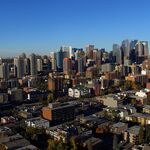ByeByeBaby
Active Member
I love that toddler density map... here's how Calgary has evolved through time over the last 20 years (in order: 2006, 2011, 2016, 2021), all with the same colour scale. I zoomed out a little to focus at the tract level on broader trends.




The thing all of this got me thinking about is actually the mid-NE; the Properties (Whitehorn, Rundle, Pineridge, Temple) and Marlborough / M. Park. Normally, suburban communities have lots of babies in the first decade or so after construction; this is really obvious both from the maps above or if you've ever known someone who bought a new house in the suburbs. The mid-NE was mostly built in the 70s or so; here's a map (from 2006 Census) showing the percent of units built 1971-1980:

The mid-NE is one of three big 70s developed clusters, along with one in the NW along Crowchild and one in the S along Anderson as well as smaller ones in the Beddington and Riverbend areas. But the mid-NE continues to have a consistent density of toddlers throughout - even though the first map is from 2006 when these communities are 25+ years old. A consistent density is exactly what makes schools the most efficient to operate (if they are provided for at least), and a higher density of toddlers means (again if the schools are provided for) more kids who can walk to school. Part of it is population density; the mid-NE has ~3-4K people per sq km while the other areas are more like ~2-3K. But a big part of it is actually having more toddlers per capita; here's the percent of 0-4 year olds from 2021:

Not wildly high like the new areas, but certainly elevated versus their 70s-80s peer communities. (You can also see the effect in the Tuxedos and Killarneys -- not just denser population, a more age-balanced one.)
The thing all of this got me thinking about is actually the mid-NE; the Properties (Whitehorn, Rundle, Pineridge, Temple) and Marlborough / M. Park. Normally, suburban communities have lots of babies in the first decade or so after construction; this is really obvious both from the maps above or if you've ever known someone who bought a new house in the suburbs. The mid-NE was mostly built in the 70s or so; here's a map (from 2006 Census) showing the percent of units built 1971-1980:
The mid-NE is one of three big 70s developed clusters, along with one in the NW along Crowchild and one in the S along Anderson as well as smaller ones in the Beddington and Riverbend areas. But the mid-NE continues to have a consistent density of toddlers throughout - even though the first map is from 2006 when these communities are 25+ years old. A consistent density is exactly what makes schools the most efficient to operate (if they are provided for at least), and a higher density of toddlers means (again if the schools are provided for) more kids who can walk to school. Part of it is population density; the mid-NE has ~3-4K people per sq km while the other areas are more like ~2-3K. But a big part of it is actually having more toddlers per capita; here's the percent of 0-4 year olds from 2021:
Not wildly high like the new areas, but certainly elevated versus their 70s-80s peer communities. (You can also see the effect in the Tuxedos and Killarneys -- not just denser population, a more age-balanced one.)




